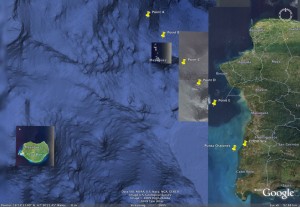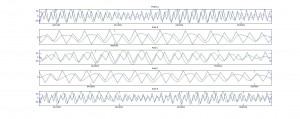-
Puerto Rico CDDO Tidal Analysis
Posted on July 6th, 2009 No commentsThis figure shows the five points selected for comparison. They are spaced at10km intervals and at a 325˚ heading from the CDDO site. They were chosen because they provide a great deal of information regarding the v (north south) component, which is the predominant flow component along the west coast of the island.
Radial data was gathered from the CDDO site in Puerto Rico for the month of April. This data was subsequently analyzed using Rich Pawlowicz’s T_Tides Matlab toolbox. The following figure illustrates the CODAR output (shown in green) for a set of five points located in the Mona channel against Punta Ostiones tidal current predictions by NOAA (shown in blue). V (north-south) current velocity component was used for comparison.
It is known that tides along the west coast of Puerto Rico are semidiurnal. However, T_tides is only calculating the diurnal component of the observed tides. This may be due the fact that T_tides is currently set to calculate only 4 Tidal constituents: O1, K1, M2, S2, which might not be the most influential constituents in this particular area of the world. Nevertheless both data sets seem to be in considerable agreement, when the semidiurnal component is ignored.It is important to note that CODAR output was initially compared with NOAA’s sea level observations at Mayaguez. This however, yielded inconclusive results.
Last 5 posts by admin
- Quality Control of Bistatic Signals - June 7th, 2012
- Radial Coverage for March 2012 - April 23rd, 2012
- ru23 as a drifter, Travis Analysis - February 14th, 2012
- Fisher Island - Ideal Pattern Results - February 2nd, 2012
- Yorktown Express - January 31st, 2012





